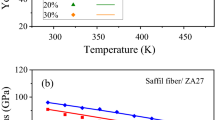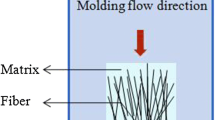Abstract
In this paper, based on our previous study regarding the temperature-dependent yield strength for metallic materials and the existing strengthening theories, a physics-based temperature dependent compressive yield strength model for short fiber reinforced magnesium alloy matrix composites was developed. This model was verified by comparison with the experimental data of seven types of magnesium alloy matrix composites. Good agreement between the model predictions and the experimental data was obtained, which fully validates the reasonability of the present model. Moreover, based on the model and the existing material parameters, the influencing factor analysis for short fiber reinforced magnesium alloy matrix composites was systematically conducted. Some novel insights regarding the control mechanism of their temperature dependent compressive yield strengths were provided.











Similar content being viewed by others
References
Jayalakshmi S, Kailas SV, Seshan S (2002) Tensile behaviour of squeeze cast AM100 magnesium alloy and its Al2O3 fibre reinforced composites. Compos Part A Appl Sci Manuf 33(8):1135–1140
Zhang XZ, Zhang Q, Hu H (2014) Tensile behaviour and microstructure of magnesium AM60-based hybrid composite containing Al2O3 fibres and particles. Mat Sci Eng A 607:269–276
Chen ZH (2007) Heat-proof magnesium alloy. Chemical Industry Press, Beijing
Dey A, Pandey KM (2015) Magnesium metal matrix composites—a review. Rev Adv Mater Sci 42:58–67
Trojanová Z, Gärtnerová V, Lukáč P, Drozd Z (2004) Mechanical properties of Mg alloys composites reinforced with short Saffil® fibres. J Alloy Compd 378(1):19–26
Trojanová Z, Száraz Z, Lábár J, Lukáč P (2005) Deformation behaviour of an AS21 alloy reinforced by short Saffil fibres and SiC particles. J Mater Process Tech 162:131–138
Trojanová Z, Száraz Z (2005) Mechanical properties of AS21 magnesium alloy based composites. Trans Tech Publ, Mater Sci Forum, pp 363–366
Trojanová Z, Drozd Z, Kúdela S, Száraz Z, Lukáč P (2007) Strengthening in Mg–Li matrix composites. Compos Sci Technol 67(9):1965–1973
Liu J, Qi LH, Zhang HY, Hou HP (2015) Effect of liquid–solid extrusion on the high-temperature compressive properties of Csf/Mg composites. Mater Manuf Process 30(11):1391–1396
Ataya S, El-Magd E (2007) Quasi-static behavior of Mg-alloys with and without short-fiber reinforcement. Theor Appl Fract Mech 47(2):102–112
Liu J, Qi LH, Guan JT, Ma YQ, Zhou JM (2012) Compressive behavior of Csf/AZ91D composites by liquid–solid extrusion directly following vacuum infiltration technique. Mat Sci Eng A 531:164–170
Rudajevová A, Lukáč P (2003) Thermal strain in Mg composites. Acta Mater 51(18):5579–5586
Farkas G, Trojanová Z, Száraz Z, Minárik P, Máthis K (2015) Effect of the fiber orientation on the deformation mechanisms of magnesium-alloy based composite. Mater Sci Eng A 643:25–31
Farkas G, Máthis K, Pilch J, Minárik P, Lukáš P, Vinogradov A (2017) Deformation behavior of Mg-alloy-based composites at different temperatures studied by neutron diffraction. Mater Sci Eng A 685:284–293
Karbhari VM, Wilkins DJ (1991) An “engineering” modification to the shear-lag model as applied to whisker and particulate reinforced composites. Scripta Metall Mater 25(3):707–712
Nardone VC, Prewo KM (1986) On the strength of discontinuous silicon carbide reinforced aluminum composites. Scripta Metall 20(1):43–48
Zhang CY, Qiu YP (2003) Modified shear lag model for fibers and fillers with irregular cross-sectional shapes. J Adhes Sci Technol 17(3):397–408
Ryu HJ, Cha SI, Hong SH (2003) Generalized shear-lag model for load transfer in SiC/Al metal-matrix composites. J Mater Res 18(12):2851–2858
Jiang ZH, Lian JS, Yang DZ, Dong SL (1998) An analytical study of the influence of thermal residual stresses on the elastic and yield behaviors of short fiber-reinforced metal matrix composites. Mat Sci Eng A 248(1–2):256–275
Arsenault RJ, Shi N (1986) Dislocation generation due to differences between the coefficients of thermal expansion. Mat Sci Eng 81:175–187
Clyne TW, Withers PJ (1993) An introduction to metal matrix composites. Cambridge University Press, Cambridge
Taylor GI (1934) The mechanism of plastic deformation of crystals. Part I. Theor Proc R Soc Lond Ser A 145(855):362–387
Ashby MF (1993) Criteria for selecting the components of composites. Acta Metall Mater 41(5):1313–1335
Luster JW, Thumann M, Baumann R (1993) Mechanical properties of aluminium alloy 6061–Al2O3 composites. Mater Sci Tech-lond 9(10):853–862
Lilholt H (1991) Aspects of deformation of metal matrix composites. Mat Sci Eng A 135:161–171
Hall EO (1951) The deformation and ageing of mild steel: III discussion of results. Proc Phys Soc Lond B 64(9):747–753
Petch NJ (1953) The cleavage strengh of polycrystals. J Iron Steel Inst 174:25–28
Zou ZX, Xiang JZ, Xu SY (2012) Theoretical derivation of Hall-Petch relationship and discussion of its applicable range. Phys Exam Test 30(6):13–17
Fu EG, Li N, Misra A, Hoagland RG, Wang H, Zhang X (2008) Mechanical properties of sputtered Cu/V and Al/Nb multilayer films. Mat Sci Eng A 493(1–2):283–287
Tang XF, Wang BY, Huo YM, Ma WY, Zhou J, Ji HC et al (2016) Unified modeling of flow behavior and microstructure evolution in hot forming of a Ni-based superalloy. Mat Sci Eng A 662:54–64
Zhang XH, Li WG, Ma JZ, Geng PJ, Shao JX, Wu XZ (2017) A novel temperature dependent yield strength model for metals considering precipitation strengthening and strain rate. Comp Mater Sci 129:147–155
Arsenault RJ, Taya M (1987) Thermal residual stress in metal matrix composite. Acta Metall 35(3):651–659
ASM International Handbook Committee (1990) ASM Handbook, volume 2, properties and selection: nonferrous alloys and special-purpose materials. ASM International, Materials Park, OH
Magnesium AS21-F, Die Cast, http://www.matweb.com/search/DataSheet.aspx?MatGUID=b910504d247f418e8e70a10ad0f549c2&ckck=1. Accessed 21 Oct 2017
Magnesium AE42-F, Die Cast, http://www.matweb.com/search/DataSheet.aspx?MatGUID=503232647ec44a408f191d57dd336ea5&ckck=1. Accessed 21 Oct 2017
Lavrentev FF, Pokhil YA, Zolotukhina IN (1978) Analysis of pairwise dislocation interaction and its contribution to flow stress during magnesium crystal basal slip. Mat Sci Eng 32(2):113–119
Murray JL (1982) The Al–Mg (aluminum–magnesium) system. J Phase Equilib 3(1):60–74
Luo A, Pekguleryuz MO (1994) Cast magnesium alloys for elevated temperature applications. J Mater Sci 29(20):5259–5271. https://doi.org/10.1007/BF01171534
Aune TK, Westengen H (1995) Property update on magnesium die casting alloys. SAE Technical Paper 950424
MIL-HDBK-5H (1998) Metallic materials and elements for aerospace vehicle structures. In: Knovel Interactive ed: U.S. Department of Defense
Akbulut H, Durman M, Yilmaz F (1998) High temperature Young’s modulus of alumina short fibre reinforced Al-Si MMCs produced by liquid infiltration. Mater Sci Tech-lond 14(4):299–305
Li WX (2005) Magnesium and magnesium alloys. Central South University Press, Changsha
Rudajevová A, Lukáč P (2005) Comparison of the thermal properties of AM20 and AS21 magnesium alloys. Mat Sci Eng A 397(1–2):16–21
Trojanová Z, Száraz Z, Palček P, Chalupová M (2011) Magnesium alloys based composites. In: Czerwinski F (ed) Magnesium alloys-design, processing and properties. InTech, Rijeka, pp 501–526
Zhang P (2005) Creep behavior of the die-cast Mg–Al alloy AS21. Scripta Mater 52(4):277–282
Counts WA, Friák M, Raabe D, Neugebauer J (2009) Using ab initio calculations in designing bcc Mg–Li alloys for ultra-lightweight applications. Acta Mater 57(1):69–76
Trojanová Z, Lukác P, Kainer KU, Gärtnerová V (2005) Dynamic strain ageing during stress relaxation in selected magnesium alloys containing rare earth elements. Adv Eng Mater 7(11):1027–1032
Lü Z, Zhou J, Sun ZM, Chen RS (2013) Effect of rare earth elements on the structures and mechanical properties of magnesium alloys. Chin Sci Bull 58(7):816–820
Tian WL, Qi LH, Zhou JM, Guan JT (2014) Effects of the fiber orientation and fiber aspect ratio on the tensile strength of Csf/Mg composites. Comp Mater Sci 89:6–11
Acknowledgements
This work was supported by the National Natural Science Foundation of China under Grant Nos. 11672050, 11472066, 11727802 and 11602044, the Fundamental Research Funds for the Central Universities under Grant No. 106112017CDJQJ328840 and the Chongqing University Graduate Student Research Innovation Project under Grant No. CYS17016. We also thank the three anonymous reviewers for their helpful comments.
Author information
Authors and Affiliations
Corresponding authors
Ethics declarations
Conflict of interest
The authors declare that they have no conflicts of interest.
Rights and permissions
About this article
Cite this article
Shao, J., Li, W., Wang, R. et al. Temperature dependent compressive yield strength model for short fiber reinforced magnesium alloy matrix composites. J Mater Sci 53, 6065–6079 (2018). https://doi.org/10.1007/s10853-017-1980-y
Received:
Accepted:
Published:
Issue Date:
DOI: https://doi.org/10.1007/s10853-017-1980-y




